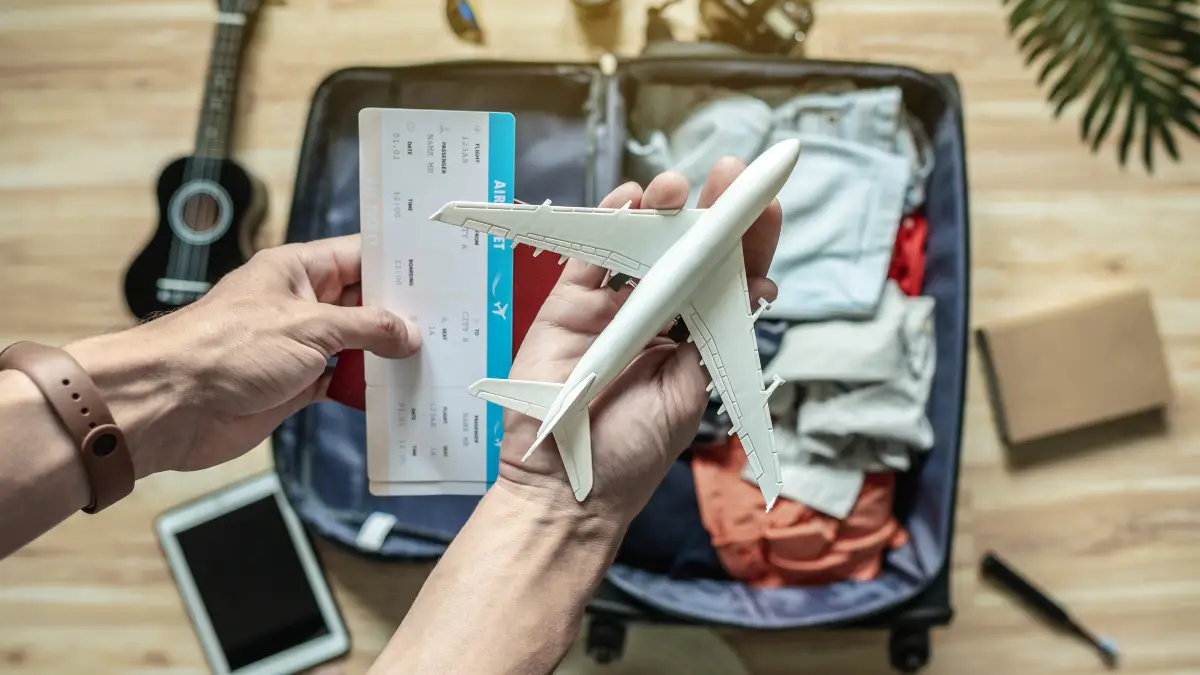Flying on a Friday feels like a punishment. You’re paying top dollar for long lines, crowded gates, and the constant stress of delays. So why do the world’s most successful people seem to glide through their travels without a hitch?
The rumor is they fly on Wednesdays, a day when airports are quiet and fares are low. While you won’t find Jeff Bezos in coach, the real secret is the mindset they use: a total avoidance of peak times and a focus on efficiency.
This guide breaks down that elite strategy. You will learn how to apply their thinking to commercial travel, using data to find the cheapest, smoothest flights. It’s not a simple trick; it’s a smarter way to see the world.
How Billionaires Really Fly

To use the strategy, you first need to know where it comes from. The idea of a billionaire in a normal airport is mostly a myth. The super-rich don’t just fly first class. They use a totally separate system for flying that is built to avoid the delays and problems that define regular travel.
They Fly on Private Jets
For the very rich, private jets are the standard. It’s not just a preference; it’s a tool. People like Jeff Bezos and Elon Musk use their Gulfstream jets for business and personal life. The private jet market is huge and growing, which shows that the elite have changed how they travel for good.
They choose private jets for reasons beyond just luxury. For important business deals or private family matters, you can’t beat the privacy of your own plane. Bernard Arnault, the CEO of LVMH, sold his private jet and started renting them just so people on Twitter would stop tracking his flights.
A private jet is also a flying office. It has fast internet and meeting tech, so work can continue in the air. This turns travel time from a waste into a productive part of the day.
As more top executives fly private, commercial airlines have to make their money from the rest of us. This makes them raise prices during busy times, which is why avoiding those peak days is so important for regular travelers.
They Value Time and Avoid Hassle
The difference between flying commercial and private is huge. A private traveler doesn’t even go into the main terminal. They show up at a small, private terminal just 15 or 20 minutes before their flight.
There are no lines and no crowds. Security is fast and private. Customs officials often come right onto the plane, which saves even more time. The whole thing is designed to be easy.
This control covers the entire trip. Billionaires have pilots on standby 24/7, ready to go anywhere at any time. They can fly directly to thousands of smaller airports that big planes can’t use. This cuts down on ground travel time.
Even the experience on the plane is perfectly planned. Many travel with personal chefs. Some even pack their own bed sheets and soap to make it feel more like home. This isn’t just about being spoiled; it’s about creating a predictable, low-stress world for themselves.
The Real Takeaway for You
So, you’re probably not going to see a billionaire on your Wednesday flight. Most of them never fly commercial.
But that doesn’t mean the idea is useless. The title is a metaphor. The secret isn’t that a billionaire is on your flight. The secret is the principle they live by: they completely avoid peak-demand systems.
The super-rich use their money to buy their way out of the system the rest of us use. The real question is, how can you use that same idea from inside the system?
Think Differently: The Real Secret Is a Mindset

The choice to fly private isn’t about feelings; it’s a simple calculation of value. If you can grasp the thinking behind that choice, you can start making smarter travel decisions. The real “billionaire secret” is a way of thinking that puts time and predictability first.
Your Time Is a Valuable Thing
For the super-rich, time is the one thing they can’t get more of. Every travel choice is made to save as much of it as possible.
Wasted hours in an airport are a huge loss. Using a helicopter to get from the city to the airport is a perfect example. They are choosing to literally fly over the traffic.
This changes how you think about “cheap” and “expensive.” A $50,000 private flight that saves a CEO eight hours might be a better investment than a $1,200 first-class ticket that kills a whole day.
They aren’t just buying a flight; they are buying time. This idea—valuing time over money—is the key to their travel strategy.
Why Smooth Travel Matters
Besides saving time, there’s a huge mental benefit to getting rid of unpredictability. Flying on a busy Friday or Sunday isn’t just more expensive; it’s more stressful. You get longer lines, fuller planes, and a higher chance of delays.
The billionaire mindset is all about removing that stress. By flying private, they control everything. You can apply this same idea to your own travel. The billionaire avoids the commercial system completely. You can avoid it on its busiest and most chaotic days.
This shows what smart travel really is. Airline prices are set by computers that are designed to charge the most during predictable busy times.
Billionaires use private jets to get out of that game. You can’t leave the game, but you can play it smarter.
By flying on a Wednesday, you are picking the system’s weakest point—a time with low demand when the computers have to lower prices to fill seats. It’s the closest you can get to beating the system.
How to Use This for Your Next Flight

When you apply the billionaire’s efficiency mindset to commercial airlines, you get a clear, data-backed strategy.
By finding and using the lulls in travel demand, anyone can have a cheaper and more pleasant trip. The data clearly shows that the middle of the week is the best time to fly.
The Data Proves It: Fly Midweek
Tons of data from travel experts show that flying in the middle of the week is almost always the cheapest option.
Tuesdays and Wednesdays have the lowest fares. The savings are real. Flying midweek can save you an average of $56 per ticket. During busy travel seasons like spring and summer, that can be over $60, and over $100 during the holidays.
Saturday is also a good day for domestic travel, with flights costing about 17% less than on Sunday, the most expensive day. For international trips, Wednesday and Saturday are often the cheapest days to leave.
Leaving for Europe on a Wednesday can save you around 10% compared to leaving on a Friday. This works because these days are in the gap between when business and vacation travelers fly. Airlines have to lower prices on these days to fill empty seats.
Why Fridays and Sundays Cost More
The reason midweek flights are cheaper is because of how weekends are priced. Fridays and Sundays are always the most expensive days to fly.
Vacationers usually leave on Friday and come back on Sunday to get the most out of their trip. At the same time, many business travelers fly out on Monday and come home on Thursday or Friday.
This creates a huge spike in demand at the beginning and end of the week. This leaves Tuesday, Wednesday, and Saturday as the quiet days with lower prices.
Airline pricing computers are built to take advantage of the weekend rush, so they charge a lot more for the convenience of a Friday or Sunday flight.
Forget the Booking Day Myth: It’s When You Fly That Matters
You may have heard that you should always book your flights on a Tuesday to get the best deal. This is old advice that doesn’t really work anymore. Today, prices are set by smart computers that are always changing. The idea of a single “best” day to book is a myth.
Some studies show small savings for booking on certain days. For example, one report says booking on a Sunday can save you a little money.
But the big travel sites agree that it doesn’t make much of a difference. A Google Flights study found that you only save about 1.9% by booking midweek instead of on the weekend.
The takeaway is simple: stop worrying about the day you book and focus on the day you fly. That’s the one thing that will have the biggest and most reliable impact on the price.
| Day of Week | Domestic Flight Cost | International Flight Cost | Why It’s Priced This Way |
| Sunday | Most Expensive | Most Expensive | Peak Day: Vacationers fly home for the work week. Business travelers fly out for Monday meetings. |
| Monday | Expensive | Standard | Business Rush: The main day for business travelers to fly out. High demand means high prices. |
| Tuesday | Cheapest | Cheapest | Midweek Lull: The rush is over. It’s quiet before the weekend travel starts. Low demand from everyone. |
| Wednesday | Cheapest | Cheapest | Best Value: The absolute slowest travel day of the week. Almost always the cheapest day to fly. |
| Thursday | Standard | Standard | Getting Busy: Business travelers start to head home. Some people start their weekend trips early. |
| Friday | Expensive | Expensive | Peak Day: The main day for weekend trips to start. Business travelers fly home. High demand. |
| Saturday | Cheap | Cheap | Good Value: A surprisingly slow day. Most vacationers are already where they want to be. A great alternative to Sunday. |
An Advanced Guide to Smart Travel Timing
Thinking like a billionaire goes beyond just picking the right day. A truly smart strategy means mastering the whole travel calendar, from knowing the best time to buy your tickets to handling holiday travel.
The Best Time to Buy Your Tickets
While the day you book doesn’t matter much, the timing does. Booking too early or too late can cost you. Here are the sweet spots:
- Domestic Flights: The best time to book is one to three months before your trip. Flights bought in this window are about 25% cheaper than last-minute tickets.
- International Flights: You need to plan further ahead. For most international trips, book three to six months in advance for the best prices. For popular trips, like Europe in the summer, book four to six months out.
- Seasonal Prices: Prices change with the seasons. They start to go up for spring travel in late February. Summer prices start to climb in early June. Prices drop a lot after late August, with September being a great time to find deals, especially for midweek flights.
Holiday Travel Cheat Sheet
Holidays are the toughest time to travel. Prices go way up. But even here, you can save money by avoiding the busiest days.
- Thanksgiving: Book your flight by Halloween at the latest. Prices get much worse in November. The worst day to fly is the Wednesday before Thanksgiving. The Sunday after is the worst day to return. The best plan is to fly on less popular days. Leave on the Sunday, Monday, or Tuesday before the holiday, or even on Thanksgiving Day itself. To come back, fly on Black Friday or the following Monday or Tuesday.
- Christmas: Book Christmas flights by Thanksgiving. The cheapest days to leave are often early in the week before Christmas (like December 16-18). Flying on Christmas Eve or Christmas Day is also a great way to save. The days right after Christmas are very expensive. The best days to return are often New Year’s Eve or New Year’s Day, when fewer people are flying.
| Holiday | Cheapest Days to Leave | Most Expensive Days to Leave | Cheapest Days to Return | Most Expensive Days to Return |
| Thanksgiving 2025 | Nov 23, 24, 25 Nov 27 (Thanksgiving Day) | Nov 26 (Wednesday before) | Nov 28 (Black Friday) Dec 1, 2 | Nov 30 (Sunday after) |
| Christmas 2025 | Dec 16, 17, 18 Dec 24 (Christmas Eve) Dec 25 (Christmas Day) | Dec 21, 22, 23 | Dec 29, 30 Dec 31 (NYE) Jan 1 (NYD) | Dec 27, 28 |
Use the Clock to Your Advantage
The time of day you fly can also save you money. The flights that most people don’t want are often the cheapest. Early morning flights (before 8 a.m.) and late-night red-eye flights (after 10 p.m.) usually have lower fares.
These times are less convenient for families and business travelers. This is another way to apply the “billionaire mindset”: choose the path that others avoid. By picking a flight that most people find inconvenient, you can get a cheaper ticket and a less crowded airport.


